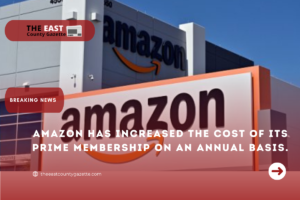Earlier this month, Amazon announced that the price of its Prime membership would increase. The company cited rising wages and transportation costs as justification for the price increase.
On Thursday, the online retailing behemoth announced a price increase for its Prime subscription service, following the release of strong fourth-quarter sales figures.

As a result of sales of $137.4 billion during the three-month period ending December 31, 2021, Amazon earned a profit of $14.3 billion. It is the company’s fifth consecutive quarter in which revenue exceeds $100 billion, as Americans sought relief from the pandemic through online retail therapy during the outbreak.
As a result, Amazon’s earnings surpassed Wall Street expectations, and the company’s stock soared 13 percent in after-hours trading.
Membership in Amazon Prime has increased.
The cost of an annual membership in Amazon Prime will rise to $139 from its current $119 price, a 9% increase. Subscribers to Amazon Prime who pay on a monthly basis will see their costs rise by $2, to approximately $15 per month.
Read More: Layoffs and Unemployment Reaches Historic Lows. But Don’t Believe the Numbers Blindly
With the $20 price increase for an annual Prime membership, Amazon is charging a 17 percent premium — or roughly three times the rate of inflation right now.
According to Amazon’s announcement, those who sign up for Prime for the first time will be charged a higher price starting on February 18, while current members will be charged a higher price after March 25, or whenever their membership is renewed.
Amazon increased the price of its Prime membership for the first time in 2018 and the previous year in 2014. An Amazon Prime membership subscription entitles members to receive free and expedited shipping on a wide range of products, as well as access to the company’s media library.
According to Insider Intelligence’s research, nearly two-thirds of all households in the United States have a prime membership. Neil Saunders, an analyst at GlobalData Retail, stated in a research note that any cancellations by consumers who are turned off by the price hike will likely be minimal.
“In spite of this, the program continues to provide excellent value for money. It is also true that, in contrast to Netflix, Amazon has not raised its prices on a regular basis “Saunders was the author.
Pandemic adversity
Seattle-based During the COVID-19 outbreak, Amazon was one of the few retailers to see a significant increase in sales. As physical stores that sold non-essential items were forced to close for a period of time or permanently, homebound people turned to Amazon for everything from groceries to cleaning supplies.
However, growth has slowed as newly vaccinated Americans have grown more confident in their ability to venture out into the world. In addition, the company, like many others, is dealing with global supply chain issues as well as a shortage of qualified employees.
“For the same reasons as all retailers, Amazon has been subjected to inflationary pressures throughout its supply chain and logistics operations, and it has been unable to mitigate the pressure despite its large volume, scale, and characteristic efficiency. Operating costs have increased by 12.9 percent, with a 10 percent increase in labor costs “As Saunders put it: “shipping costs.”
Amazon’s operating income dropped by nearly half in the most recent quarter, prompting the company to look for new sources of revenue growth, including raising the price of its Prime membership.
In his article, Saunders writes, “It is now clear that Amazon will have to work much harder in order to generate future gains, especially given the fact that competitors are putting in much more effort with their omnichannel and digital services.”
